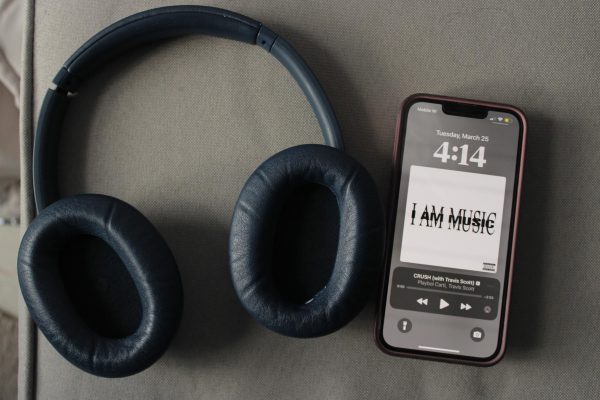How Two Robot Musicians Taught People to be Human

Daft Punk released their first album “Homework” in 1997. (Courtesy of Twitter)
The concept of separating the digital from the physical, and the philosophical idea that there is inherent inhumanity in the design of the modern digital landscape has always played a central role in Daft Punk’s music.
From the digital DJ-ing present on 1997’s “Homework” to the analog instrumentals of 2013’s “Random Access Memories,” the trajectory of Daft Punk’s career has always followed a journey of understanding and accepting the human essence, while taking a step back and immersing the physical in the digital.
When the duo, Thomas Bangalter and Guy-Manuel de Homem-Christo, released their first album, “Homework,” in 1997, the tracklist was less of a thematic work of art and more of a simple compilation of dance songs to be played live. However, the legacy of“Homework” is still incredibly important for revitalizing house music, moving the French club scenes away from the Eurodance beat direction and towards a new era of progressive, electronic and heavily technologic music.
Repetitive music, heavy beats, synthesized voices or, in other words, the trademark Daft Punk elements, were all present in “Homework,” establishing the duo as a unit whose musical production was heavily rooted in the mechanical side over the human side. Forgoing real instruments in favor of digital production, the transition to “robothood” was present from the very beginning.
Between the release of “Homework” and the production of their second album “Discovery,” as the duo toured from club to club, they did so without the Daft Punk style. Bangalter and de Homem-Christo wore face masks to conceal their identities, but this was less of an attempt at dehumanization and more an avoidance of a culture of idolization. Masks forced the audience to focus on the music and dance floors instead of the fingers controlling turntables.
In 1999, as the group was beginning work on “Discovery,” Bangalter and de Homem-Christo unveiled their new identities as Daft Punk, donning the iconic robotic helmets as they hypnotized crowds of dancers. This is the moment Daft Punk came into its thematic essence of using technological production to explore human behavior and philosophy.
Aside from its important legacy of bringing disco back into mainstream pop music by infusing it with house music, “Discovery” also curated a very human experience for its listeners. This experience was a radical departure from the dance-focused “Homework.” In an interview with Remix in 2001, Bangalter said that “Discovery” is “about the idea of looking at something with an open mind and not asking too many questions. It’s about the true, simple and honest relationship you have with music when you’re open to your own feelings.” This was all done, of course, in conjunction with the heavy digital production of the album.
“Discovery” invokes multiple natural human behaviors from the eponymous need to discover to the longing for connection. As a child, we want to discover. We want to understand the world around us and process it through our own perspective, becoming one with the world. In the same way that the listener is asked to discover a new relationship with music, getting lost in the complex sampling and mixes while their body becomes a physical conduit for the music. At the same time, it begs the listener to connect with the music, to respond to it and to free the mind on the dance floor. Once a listener can do that, that very same dance floor opens the connection between listeners in a human network of emotion.
Daft Punk followed the logical step with their follow-up album, 2005’s “Human After All,” fully exploring the relationship between humanity and mechanics. If “Discovery” was the introduction of humanity, then “Human After All” would grapple with humanity and technology conflicting with each other as fully developed existences. The album was a sonic departure from “Homework” and “Discovery” in that its production was much darker, more unstable and evoked a sense of paranoia instead of euphoria.
“Human After All” doesn’t describe the coexistence of the human and the mechanical realm, but instead having the two concepts as incompatible forces of conflict. It wouldn’t be until Daft Punk’s final album, 2013’s “Random Access Memories,” where the two modes of being were finally merged and accepted as two parts of a whole.
What makes “Random Access Memories” so radically different from Daft Punk’s previous studio albums is the instruments. For the first time in Daft Punk’s history, the sounds of synthesizers and electronic instruments took a backseat to guitars and analog instruments. Synthesizers, symbolic of Daft Punk’s core roboticism, and the analog instruments, reflective of the human soul, were played together in harmony unprecedented in the duo’s career.
The songs on this album continue this theme as well, with tracks like “Touch” and “Contact” showcasing the “parallel between the brain and the hard drive – the random way that memories are stored,” as Bangalter said in an interview with Rolling Stone.
When all of Daft Punk’s discography is taken into account, a clear journey of humanity presents itself. From the beginning of pure mechanical robotics to an end that eventually learned how to balance the human spirit with the mechanical world, Daft Punk’s music reflected an identity crisis familiar to anyone who has ever wanted to find their place in the world.
When Daft Punk had nothing left to teach us, the duo self-destructed like a star whose light was no longer needed.

Sebastian Diaz is a senior from Chapel Hill, N. C. who is double majoring in journalism and film. After starting as a news reporter for The Fordham Ram...












































































































































































































